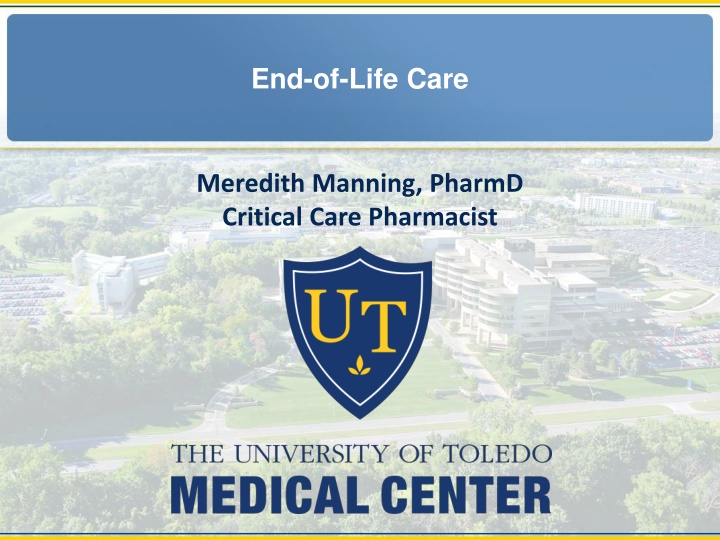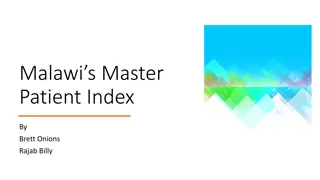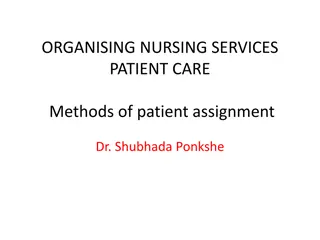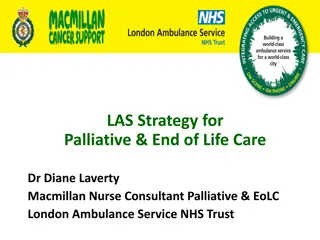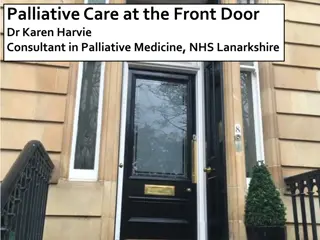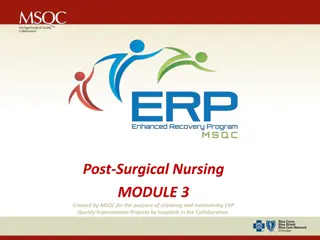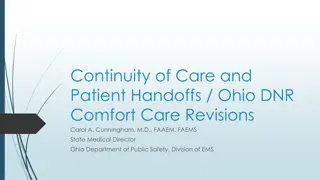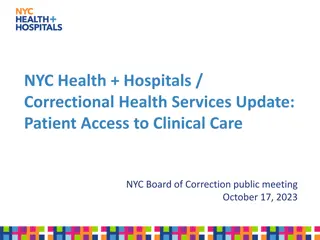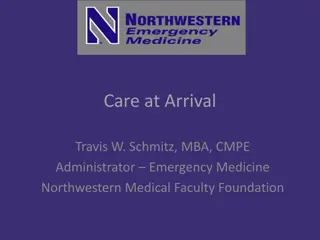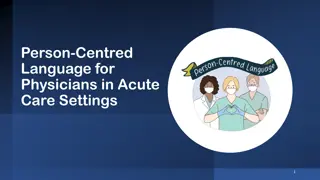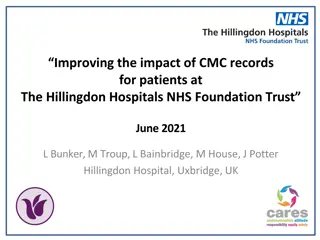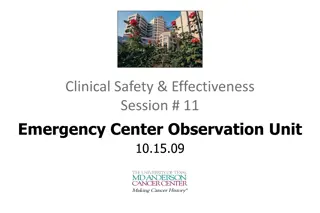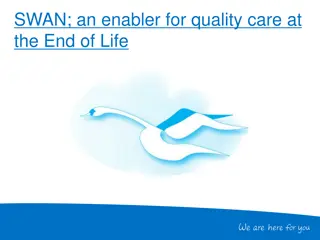End-of-Life Care and Patient Management
Our patient, LJ, a 71-year-old male with a complex medical history, presents with respiratory distress. Explore the clinical scenario, history, medications, vitals, labs, and radiology findings. Gain insights into end-of-life care, family satisfaction, symptom management, and therapeutic regimens.
Download Presentation

Please find below an Image/Link to download the presentation.
The content on the website is provided AS IS for your information and personal use only. It may not be sold, licensed, or shared on other websites without obtaining consent from the author.If you encounter any issues during the download, it is possible that the publisher has removed the file from their server.
You are allowed to download the files provided on this website for personal or commercial use, subject to the condition that they are used lawfully. All files are the property of their respective owners.
The content on the website is provided AS IS for your information and personal use only. It may not be sold, licensed, or shared on other websites without obtaining consent from the author.
E N D
Presentation Transcript
End-of-Life Care Meredith Manning, PharmD Critical Care Pharmacist
Objectives Describe the importance of end-of-life care Identify variables associated with improved family satisfaction with end-of-life care Predict symptoms likely to be experienced by patients at end of life Design a therapeutic regimen for the management of common symptoms present at end of life 2
Our patient LJ is a 71 year old male who presented to the UTMC ED via EMS with respiratory distress HPI: Recently discharged from UTMC MRSA bacteremia, C3-C4 osteomyelitis, epidural abscess E. coli and Proteus mirabilis PNA Acute respiratory distress and increased tracheal secretions during HD session Code status: Full Support 3
History PMH HTN DM ESRD on HD R femoral Quinton Chronic anemia GERD Depression PSH R BKA I&D of epidural abscess (10/20/17) Tracheostomy (11/1/17) Allergies APAP (unknown) 4
History SH Nursing home resident Former cigarette smoker Denies alcohol and illicit drug use FH Noncontributory 5
Medications prior to admission Doxycycline 100 mg BID Calcium acetate 667 mg TID Levofloxacin 500 mg IV q48h Darbepoetin 60 mcg SC weekly Amlodipine 10 mg daily *Ferrous sulfate 325 mg daily Metoprolol tartrate 5 mg IV q6h *Ondansetron 4 mg IV q6h prn *Nitroglycerin 0.4 mg SL as directed *Pantoprazole 40 mg IV daily Unfractionated heparin 5000 unit SC q8h *Polyethylene glycol 17 g daily prn *Lorazepam 0.5 mg IV q6h prn *Senna-docusate 2 tab daily *Mirtazapine 15 mg qHS Tizanidine 4 mg q8h prn *Insulin aspart SC sliding scale Chlorhexidine mouthwash Medications administered via nasogastric tube unless otherwise stated * Continued for hospital use 6
Vitals / Labs Ht 68 in; Wt 55 kg T 97.7 F; BP 84/49; HR 112; RR 20; O2Sat 98% 128 98 46 2.7 24 1.99 23.0 7.3 95 3.9 42 Ca 8.4 Lactate 3.3 Mg 1.7 Phos 1.1 7.37/45/29/26 7
Radiology Large multilobar right- sided pneumonia Blood and sputum (induced) cultures sent Empirically started on vancomycin and piperacillin-tazobactam for ventilator-associated pneumonia 8
Hospital day 1 Blood cultures (+) for Gram- negative bacilli Admitted to MICU O2Sat in the 70s SBP in the 60s norepinephrine drip Patient refusing medications son notified Son changes code status to DNRCC-A Titrated up to 2 mcg/kg/min 9
Son changes code status to DNRCC-A What does that mean? 10
Do Not Resuscitate (DNR) DNR Comfort Care (DNRCC) DNR Comfort Care Arrest (DNRCC-A) DNR Comfort Care protocol activated the moment the order is signed DNR Comfort Care protocol activated at the time of cardiac or respiratory arrest Patient receives care to ease pain and suffering Patient receives standard care up until an arrest Important to distinguish between withdrawing and withholding care No resuscitative therapies given in the event of an arrest 11
Palliative vs. Hospice Palliative care Hospice care Patient may or may not be terminally ill Patient is terminally ill (life expectancy up to 6 months) Focuses on patient well-being (physical, mental, social, spiritual) Focuses on patient comfort; prepares patient and family for patient s end of life Patient receives life-sustaining medications Patient does not receive life- sustaining medications 12
Quality of dying in the ICU: Ratings by family members Retrospective chart review and family member survey in 4 ICUs Explored associations between aspects of ICU care and experience and overall rating of the quality of the dying experience Surveyed 94 family members of 38 patients who died in the ICU Mularski et al. Chest. 2005;128:280-7 13
Quality of Death and Dying (QODD) ICU QODD Symptoms and personal care Preparation for death Having pain under control Feel at peace with dying Having control of events Be unafraid of dying Being able to feed oneself Have healthcare costs provided Being able to breath comfortably Visits from religious/spiritual advisor Treatment preferences Have a spiritual service or ceremony Discuss wishes for end-of-life care Have funeral arrangements in order Being on ventilator Say goodbye to loved ones Being on dialysis Clear up bad feelings Whole-person concerns Family concerns Finding meaning and purpose Spending time with family/friends Being touched and hugged by loved ones Spending time alone Being able to laugh and smile Moment of death Keeping one s dignity and self-respect State at moment of death Having family present at moment of death Mularski et al. Chest. 2005;128:280-7 14
Results ICU QODD: 60/100 Factors with the greatest impact on ICU QODD* Score How often patient felt at peace with dying 30/100 How often pain was under control 47/100 How often patient was in control of events 8/100 How often patient kept dignity/self-respect 32/100 * Based on multivariate analysis Mularski et al. Chest. 2005;128:280-7 15
Take home points Family members of dying patients value palliative care measures in the ICU Pain control is a major determinant of family members perceptions of the dying experience Overall, QODD scores in this study were moderate to low Mularski et al. Chest. 2005;128:280-7 16
Back to our patient Acute on chronic respiratory failure 2/2 PNA Mechanical ventilation Septic shock 2/2 PNA Norepinephrine infusion @ 0.3-0.4 mcg/kg/min Vancomycin dosed per levels with HD and meropenem 500 mg q24h per ID Persistent hypoglycemia 2/2 sepsis Repeated doses of D50W 12.5-25 g - unsuccessful Transitioned to D10W infusion @ 10 mL/hr 50 mL/hr Home medications resumed 17
Hospital day 2 ESBL E. coli bacteremia/ pneumonia Increasingly thrombocytopenic (Plt 42 11) Leukocytosis (WBC 3.9 48.0 52.6) Persistent hypoglycemia despite D10W infusion Remains on norepinephrine drip @ 0.25 mcg/kg/min Family changes code status to DNRCC 18
Family changes code status to DNRCC What does this mean? 19
Family changes code status to DNRCC What does this mean? Shift in goals of care 20
End-of-life-associated symptoms Kelley & Morrison. N Eng J Med. 2015;373:747-55 21
Symptom management: Discomfort 22
Pain 40% of dying patients in the hospital experience moderate-to-severe pain during the last 3 days of life Assessment: Verbal: visual analog scales Nonverbal: Behavioral Pain Scale (BPS) Critical-Care Pain Observation Tool (CPOT) Determine type of pain if possible Connors et al. JAMA. 1995;274:1591-8 Payen et al. Crit Care Med. 2001 Dec;29(12):2258-63 Gelinas et al. Am J Crit Care. 2006;15(4):420-7 23
Pain Management Mild pain: APAP and/or NSAIDs Moderate-to-severe pain: opioids Frequent boluses to achieve analgesia i.e., morphine 5-15 mg PO or 2-5 mg IV q30min prn Bone pain: opioid + corticosteroid i.e., dexamethasone 4-8 mg PO daily Neuropathic pain: Short survival anticipated: opioid + corticosteroid Longer survival anticipated: opioid + gabapentin (100- 300 mg daily, titrated every 1-3 days to effect) Blinderman & Billings. N Eng J Med. 2015;373:2549-61 24
High dose morphine use in the hospice setting Retrospective chart review of terminally ill cancer patients admitted to a hospice center Examined use of high dose morphine Patient characteristics Relationship between type of cancer and dosage Rate of adverse events Effect on patient survival Bercovitch et al. Cancer. 1999 Sep;86(5):871-7 25
Results 453 patients included Grouped based on morphine dose Morphine group Mean dose (mg/24 hrs) 40.7 16.9 N < 60 mg/24 hrs 215 (47.5%) 60-299 mg/24 hrs 129.3 48.8 183 (40.4%) 300-599 mg/24 hrs 388.4 65.1 19 (4%) > 599 mg/24 hrs 1305.5 1019.7 36 (8%) Bercovitch et al. Cancer. 1999 Sep;86(5):871-7 26
Survival Mean survival time: <300 mg/day: 14 days 300-599 mg/day: 15 days >599 mg/day: 13 days No statistically significant correlation between morphine dose and survival Bercovitch et al. Cancer. 1999 Sep;86(5):871-7 27
Adverse effects Constipation Nausea Vomiting Fecal impaction Urinary retention 74.6% 41.8% 36.3% 12.7% 9.1% High dose morphine was not withdrawn due to adverse effects in any patients Bercovitch et al. Cancer. 1999 Sep;86(5):871-7 28
Take home points Morphine dose does not appear to impact patient survival Adverse effects were common but mild Benefits of high dose morphine appear to outweigh perceived risks Bercovitch et al. Cancer. 1999 Sep;86(5):871-7 29
Symptom management: Respiratory 30
Dyspnea Supplemental oxygen may or may not be beneficial for symptom relief No evidence of increased benefit vs. ambient air in patients without hypoxemia (except for those with COPD), but can consider therapeutic trial NOT considered a life-sustaining treatment Management: Opioids Lower doses than those needed for analgesia are generally sufficient for dyspnea Abernethy et al. Lancet. 2010 Sep;376(9743):784-93 Blinderman & Billings. N Eng J Med. 2015;373:2549-61 31
Excessive secretions Patients generally lose the ability to clear secretions during the last few days of life May cause death rattle (gurgling sound in throat) More distressing to family and staff than to patient Management: Glycopyrrolate 0.2 mg SC or 0.1 mg SL q4-6h prn Scopolamine 0.4-0.6 mg SC q4-8h or patch q72h Atropine 0.4-0.6 mg SC q4-6h or 1-2 drops 1% ophthalmic solution q2-4h Blinderman & Billings. N Eng J Med. 2015;373:2549-61 Hugel et al. J Palliat Med. 2006 Apr;9(2):279-84 Kintzel et al. Am J Health Syst Pharm. 2009;66(5):458-64 32
Xerostomia Causes: Medications (i.e., opioids, anticholinergic drugs) Dehydration Radiotherapy to head/neck Management: Discontinuation of causative agent Saliva stimulants Saliva substitutes Hydration NOT recommended Blinderman & Billings. N Eng J Med. 2015;373:2549-61 33
Symptom management: Gastrointestinal 34
Nausea & vomiting Management based on cause: Gastroparesis: Metoclopramide 10-20 mg PO or IV q4-6h Bowel obstruction: Octreotide 100-200 mcg SC TID Dexamethasone 4-8 mg PO or IV daily Uremia, medications, multifactorial, or unknown: Haloperidol 1.5-5 mg PO or 0.5-2 mg IV TID Ondansetron 8 mg PO q8h Metoclopramide Dexamethasone Blinderman & Billings. N Eng J Med. 2015;373:2549-61 35
Symptom management: Psychological 36
Delirium Causes: Medications (i.e., opioids, benzodiazepines, anticholinergics) Inadequate analgesia Organ failure (i.e., liver, renal, respiratory) Infection Various manifestations Hyper- or hypoactivity Changes in attention, disordered thinking Restlessness Suspiciousness, hallucinations, paranoia Blinderman & Billings. N Eng J Med. 2015;373:2549-61 37
Delirium Management: Non-pharmacologic Reorientation to environment Reduction of stimulation by environment Pharmacologic Haloperidol 0.5-10 mg PO, IV, IM, SC (divided doses) Atypical antipsychotics (titrate every 2-3 days to effect) Olanzapine 2.5-20 PO, IM, SC daily Quetiapine 25-300 mg PO (2-3 divided doses) Risperidone 0.25-6 mg PO daily Ziprasidone 40-160 mg PO, IM (2 divided doses) Analgesics (if secondary to pain) Blinderman & Billings. N Eng J Med. 2015;373:2549-61 Grassi et al. Curr Psychiatry Rep. 2015;17:13 38
Anxiety & insomnia Numerous causes as patients approach end of life Management: Address patient s concerns Make patient comfortable Family involvement Benzodiazepines Shorter-acting agents allow for more rapid titration Blinderman & Billings. N Eng J Med. 2015;373:2549-61 39
Route of administration Oral Gastrostomy tube Sublingual Intravenous Subcutaneous Transdermal Rectal
Route of administration Oral Inexpensive Convenient Medications readily available Patients often lose ability to swallow as end of life approaches Gastrostomy tube Sublingual Intravenous Subcutaneous Transdermal Rectal Harlos. Oxford Textbook of Palliative Medicine. 2010.
Route of administration Oral Gastrostomy tube **If already in place** Convenient Appropriate for liquid and crushable medications Inappropriate for enteric coated or long-acting medications Sublingual Intravenous Subcutaneous Transdermal Rectal Harlos. Oxford Textbook of Palliative Medicine. 2010.
Route of administration Oral Gastrostomy tube Sublingual Convenient Increasing medication availability Absorption affected by increased oral secretions Volume limitations Intravenous Subcutaneous Transdermal Rectal Harlos. Oxford Textbook of Palliative Medicine. 2010.
Route of administration Oral Gastrostomy tube Sublingual Intravenous **If IV access maintained** Reliable Increased costs Risk of complications Subcutaneous Transdermal Rectal Harlos. Oxford Textbook of Palliative Medicine. 2010.
Route of administration Oral Gastrostomy tube Sublingual Intravenous Subcutaneous Often as effective as IV route Increased costs Risk of complications Abdominal administration preferred (decreased peripheral perfusion near end of life) Transdermal Rectal Harlos. Oxford Textbook of Palliative Medicine. 2010.
Route of administration Oral Gastrostomy tube Sublingual Intravenous Subcutaneous Transdermal Convenient Limited medication availability Does not allow for rapid dose changes Poor absorption near end of life (decreased peripheral perfusion) Rectal Harlos. Oxford Textbook of Palliative Medicine. 2010.
Route of administration Oral Gastrostomy tube Sublingual Intravenous Subcutaneous Transdermal Rectal Most medications used for end of life care are well absorbed rectally Limited dosing options May be uncomfortable for patient and/or family Harlos. Oxford Textbook of Palliative Medicine. 2010. 47
Back to our patient Medications discontinued @ 1142 Comfort care orders* placed @ 1143 Lorazepam and morphine given @ 1153 Disconnected from ventilator @ 1219 Morphine given @ 1217 Patient expired @ 1259 * Morphine 4 mg IV q20min prn signs of discomfort Lorazepam 2 mg IV q15min prn agitation 48
Case evaluation Successes: Recognition of patient s prognosis Respect for patient s wishes Appropriate medications for discomfort, agitation Areas for improvement: Abrupt discontinuation of mirtazapine, tizanidine Discontinuation of bowel regimen Lack of additional agents in anticipation of other symptoms (i.e., glycopyrrolate, haloperidol, etc.) 49
Questions? 50
